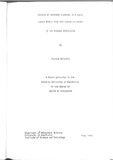| dc.description.abstract | The purpose of this study is to look at aspects of manpower planning in a local labour market with special emphasis to female nurses. Its aims are, firstly, to find out the various factors which determine the participation rate of nurses. Secondly it is aimed at providing the authorities with information which would enable them to react in the proper direction when they are facing recruitment problems and if possible to verify and codify certain characteristics of nurses and patterns of the nursing employment.
Also it is aimed to find out the pool of qualified nurses available in the district, the career profiles of the people currently employed in the locality and what has been happening to those who have successfully emerged from the nursing school in order to provide sufficient material for management to see the potential benefit of a manpower planning approach. Lastly it aims to answer a more general question, and a very contemporary one indeed, i.e. whether there is an over-production of qualified nurses in the National Health Service and hence waste of resources. This issue has become
even more urgent after the financial difficulties the NHS is facing and the recognition that training of nurses is indeed a very costly business and even more important because of the discussion concerning "Project 2000" when more qualified nurses will be needed to work in the wards. Employment in the National Health Service has suffered from continuing divergence between the demand for and the supply of nursing staff. A similar situation existed in that particular Health District, the location of the local labour market. In Spring 1980, a request came for an investigation into the nursing recruitment in the Health District which was ... becoming "increasingly difficult". By the autumn of the same year, not only was there perceived to be no shortage problem but, on the contrary, there was a plenitude of application, enough even to fill the succeeding intakes into the nursing school. Three years later, however, unemployment among qualified nurses had become a real problem. These, at least, signify a waste of scarce human and financial resources, and a justifiable scepticism is provoked about the way manpower problems are being looked at in the N.R.S., and also regarding the efficiency of personnel forecasting in the Service. Manpower planning problems, however, are so complicated that there are no clear-cut satisfactory answers to these questions. More light could be shed on them by studying the problem from various angles, and adopting different approaches. In Chapter One an attempt is being made to present the evolution of manpower planning not only as a discipline but at the same time in its application over the years in this country. The three levels of application of manpower planning, national, intermediate and micro, with emphasis on the various techniques used and difficulties faced are presented in the same Chapter. Chapters Two and Three and the ones which follow, are concerned with the rather more concrete aspects of manpower planning i.e. those which have been dealt with in the course of the project. Nursing as a profession and the necessary background material to the study is presented together with certain information concerning various institutions and procedures as well as the most recent developments in the N.R.S. Although nursing has been over the last hundred years an overwhelmingly female occupation, it is only in the past few decades that there has been a general expansion of wage labour among women. It is, therefore, necessary that any study of nurses cannot but be an examination of women in the labour process. Chapter Four deals with this historical development with particular emphasis on the developments of the labour force participation of women and the factors influencing this participation. Generating contacts with qualified nurses presents, in itself, methodological problems of some magnitude, particularly in the case where no up-to date lists are kept and especially when the aim is to go as far back as twenty years since some nurses have first been qualified. In Chapter Five, the results of these contacts are presented together with the experience gained during this exercise. Chapter Six focuses on the local labour market, its determinants and its social and economic setting. The available information concerning the Health District and its manpower is also presented here. In Chapter Seven the analysis of the data gathered from the main survey questionnaire is presented. The aim of the analysis is to provide the authorities with information on the characteristics of qualified nursing staff in order to understand more fully the staffing situation. The purpose of the comparison of the results of the present study with those of other researchers, throughout this chapter, aims firstly to detect certain patterns of movements and behaviour of the qualified nurses and, secondly, to overcome the deficiency in manpower information in order to provide a sound statistical basis for policy decisions. In Chapter Eight a summary of the main findings of the study is presented together with an attempt to take part in one of the most controversial issues, i.e. whether the N.H.S. produces more qualified nurses than this country needs with a consequent of wasting scarce human as well as material resources. | en_UK |


